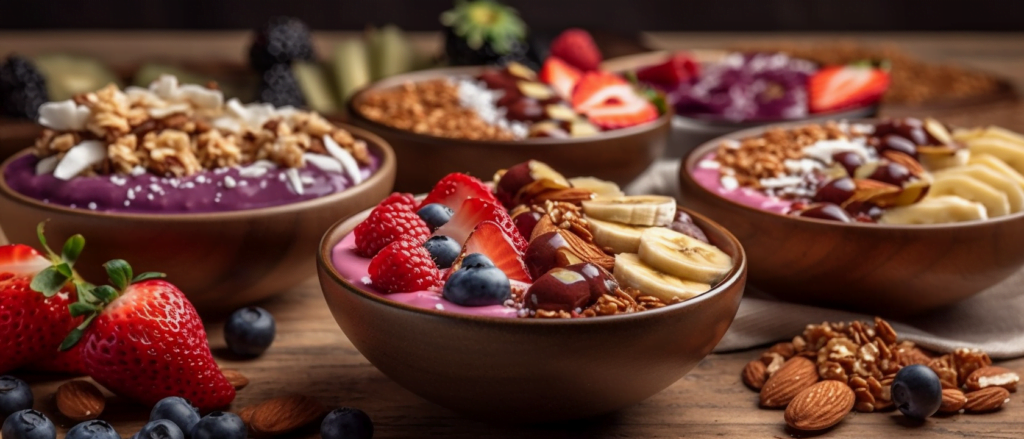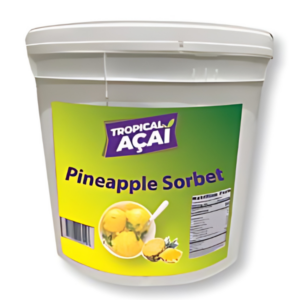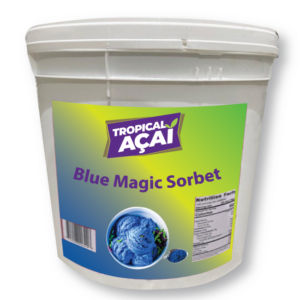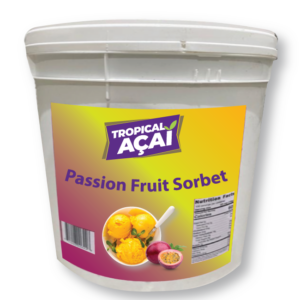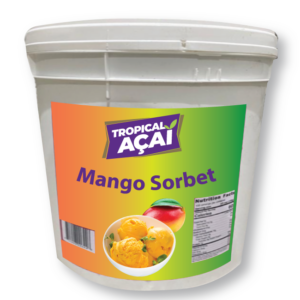Introduction
Acai bowls have recently become a popular food trend, with many people touting their health benefits and delicious taste. But what exactly is an acai bowl, and why have they gained such popularity? In this blog post, we will explore the origins of acai bowls, their nutritional content, and whether they truly live up to the hype. We’ll also discuss the controversy surrounding their health benefits and provide tips for incorporating acai bowls into a balanced diet.
What are Acai Bowls?
Acai bowls are smoothie bowls made with acai berry, a small, dark purple fruit native to the Amazon rainforest in Brazil. The acai berry is blended with other fruits and liquids like almond milk or coconut water to create a thick, smoothie-like base. This base is topped with various ingredients, including fresh fruit, granola, nuts, and seeds, making a visually appealing and delicious dish.
Why are Acai Bowls so popular?
The popularity of acai bowls can be attributed to several factors, including their vibrant appearance, unique flavor, and perceived health benefits. With the rise of social media, visually appealing foods like acai bowls have garnered a lot of attention, leading to increased interest and consumption. Additionally, the acai berry has been marketed as a “superfood” due to its high antioxidant content and potential health benefits, contributing to the popularity of acai bowls.
The controversy over the health benefits of Acai Bowls
Despite their widespread popularity, acai bowls have also been met
with some discussion regarding their actual health benefits. Critics argue that the high sugar content in some acai bowls, particularly those made with added sweeteners or calorie-dense toppings, can outweigh the potential benefits of the acai berry itself. Additionally, the lack of standardized recipes or portion sizes for acai bowls can make determining their nutritional value challenging.
Purpose of the article
This article aims to comprehensively understand acai bowls, their origins, nutritional content, and potential health benefits. We will also discuss the controversy surrounding their health claims and provide tips for making healthier choices when consuming acai bowls. By the end of this article, you should better understand whether acai bowls are a healthy option for you and how to incorporate them into your diet in a balanced way.
What is Acai?
Acai (pronounced ah-sigh-EE) is a small, dark purple berry that grows on the acai palm tree, which is native to the Amazon rainforest in Brazil. The fruit has a unique flavor, often described as a mix between dark chocolate and blackberries, with a hint of earthiness. Indigenous people in the Amazon region have consumed acai berries for centuries, but their popularity has exploded worldwide in recent years due to their purported health benefits and unique taste.
Origins of the Acai berry
The acai berry has a long history of use among the indigenous people of the Amazon rainforest. These communities have traditionally used fruit as a dietary staple and a source of natural medicine. The berries were typically consumed as a pulp or as a beverage known as “vinho de acai.” However, it wasn’t until the late 20th century that acai berries started gaining popularity outside of Brazil, thanks to their introduction to the global market as a “superfood.”
The nutritional content of Acai berries
Acai berries are rich in nutrients, including vitamins, minerals, and antioxidants. They are exceptionally high in vitamins A, E, and dietary fiber. Additionally, acai berries contain a high concentration of anthocyanins, potent antioxidants responsible for the fruit’s dark purple color. These antioxidants can help neutralize free radicals in the body, reducing the risk of chronic diseases like other disease and cancer.
Nutrition Facts:
Here is a list of the nutritional facts for 100 grams of acai berries:
- Calories: 70 kcal
- Protein: 2 g
- Fat: 5 g
- Saturated fat: 1.5 g
- Monounsaturated fat: 3.1 g
- Polyunsaturated fat: 1.1 g
- Carbohydrates: 4 g
- Dietary fiber: 2 g
- Sugars: 2 g
- Vitamins:
- Vitamin A: 50 IU
- Vitamin C: 20 mg
- Vitamin E: 10 mg
- Vitamin K: 16 μg
- Thiamin (Vitamin B1): 0.4 mg
- Riboflavin (Vitamin B2): 0.01 mg
- Niacin (Vitamin B3): 0.3 mg
- Vitamin B6: 0.05 mg
- Folate (Vitamin B9): 6 μg
- Vitamin B12: 0 μg
- Pantothenic acid (Vitamin B5): 0.3 mg
- Minerals:
- Calcium: 25 mg
- Iron: 1.5 mg
- Magnesium: 32 mg
- Phosphorus: 58 mg
- Potassium: 230 mg
- Sodium: 5 mg
- Zinc: 0.6 mg
- Copper: 0.3 mg
It’s important to note that the nutritional content of acai berries can vary depending on how they are processed and consumed. Acai is often available as a freeze-dried powder, frozen pulp, or juice concentrate. These forms may have different nutritional profiles, so it’s essential to be mindful of the specific product you are using.
Potential health benefits of Acai
Acai berries have been linked to various health benefits due to their high nutrient and antioxidant content. Some potential benefits of consuming Acai include:
- Improved general health: The antioxidants in acai berries, particularly anthocyanins, may help protect against other disease by improving cholesterol levels, reducing inflammation, and preventing blood clots.
- Anti-aging effects: The high antioxidant content in Acai may help protect cells from damage caused by free radicals, potentially reducing the risk of age-related diseases and promoting healthy aging.
- Enhanced cognitive function: Some research suggests that acai berries may have neuroprotective effects, potentially improving brain health and reducing the risk of cognitive decline.
- Immune system support: Acai berries contain nutrients, such as vitamins A and E, essential for maintaining a healthy immune system.
It’s important to note that while acai berries have been linked to these potential health benefits, more research is needed to understand their effects fully. Additionally, consuming acai berries alone does not guarantee improved health; they should be incorporated into a balanced diet alongside other nutrient-dense foods.
Understanding Acai Bowls
Acai bowls have become famous for many people looking to enjoy a nutritious and delicious meal. These bowls typically consist of a thick, smoothie-like base made from acai berries, combined with various toppings to create a satisfying and visually appealing dish.
What are Acai Bowls?
As mentioned earlier, acai bowls are smoothie bowls made with acai berries as the primary ingredient. The acai berries are usually blended with other fruits, such as bananas or strawberries, and a liquid, like almond milk, coconut water, or yogurt, to create a thick, smoothie-like consistency. The base is topped with various ingredients, including fresh fruit, granola, nuts, seeds, and even superfood powders like spirulina or maca.
Different types of Acai Bowls
Many variations of acai bowls are available, depending on personal taste preferences and nutritional goals. Some common types of acai bowls include:
- Classic Acai Bowl: A traditional acai bowl made with acai berries, banana, and almond milk, topped with granola, fresh fruit, and honey.
- Tropical Acai Bowl: An acai bowl featuring tropical fruits like pineapple, mango, or papaya blended with coconut water and topped with coconut flakes.
- Green Acai Bowl: A nutrient-dense acai bowl that includes leafy greens, such as spinach or kale, blended into the base and topped with seeds, nuts, and avocado.
- Protein-Packed Acai Bowl: An acai bowl designed to support muscle growth and recovery, with added protein powder or Greek yogurt in the base and topped with nuts, seeds, and nut butter.
These are just a few examples of the many acai bowls available. In addition, you can easily customize your acai bowl to suit your taste preferences and nutritional needs by choosing different fruits, liquids, and toppings.
Common ingredients in Acai Bowls
Acai bowls can be made with various ingredients, allowing endless combinations and flavors. Some common ingredients found in acai bowls include:
- Acai berry: The primary ingredient in acai bowls, often available as a freeze-dried powder or frozen pulp.
- Fruits: Bananas, strawberries, blueberries, mangoes, and other fruits can be blended into the base or used as toppings.
- Liquids: Almond milk, coconut water, yogurt, or juice create the desired smoothie-like consistency.
- Toppings: Granola, nuts (such as almonds, walnuts, or cashews), seeds (like chia, flax, or hemp), fresh fruit, coconut flakes, and honey or agave syrup are popular choices for toppings.
- Superfood powders: Optional add-ins like spirulina, maca, or cacao powder can be mixed into the base for added nutrition and flavor.
The ingredients you choose for your acai bowl will determine its nutritional content and health benefits. Selecting nutrient-dense ingredients and avoiding excessive amounts of added sugars can create a healthier, more balanced acai bowl.
Are Acai Bowls Healthy?
Whether acai bowls are healthy depends on the ingredients used and portion sizes. Acai bowls can be a nutritious addition to a balanced diet when made with nutrient-dense ingredients and consumed in moderation. However, some acai bowls may be high in sugar or calories, negating their potential health benefits.
Pros and cons of Acai Bowls
Pros:
- Nutrient-dense: Acai bowls can be a good source of vitamins, minerals, and antioxidants, mainly made with various fruits, nuts, and seeds.
- Customizable: Acai bowls can be easily adapted to suit individual tastes and dietary needs.
- Satiating: Combining fiber from fruits and healthy fats from nuts and seeds can help keep you full and satisfied.
Cons:
- High sugar content: Some acai bowls can be high in sugar, mainly made with added sweeteners or calorie-dense toppings.
- Calorie-dense: Depending on the ingredients used, acai bowls can be high in calories, which may not be ideal for those looking to lose weight.
- Inconsistent portion sizes: Portion sizes for acai bowls can vary greatly, making it difficult to gauge their nutritional content and potential health benefits.
How Acai Bowls can fit into a balanced diet
Acai bowls can be a healthy part of a balanced diet when consumed in moderation and made with nutrient-dense ingredients. To make a more nutritious acai bowl:
- First, choose whole, natural ingredients like fresh fruits, nuts, and seeds.
- Limit added sugars by using unsweetened acai products and avoiding excessive sweeteners.
- Incorporate a variety of fruits, nuts, and seeds to maximize the nutrient content.
- Finally, be mindful of portion sizes, and consider sharing a larger bowl or saving half for later.
Risks and side effects of consuming Acai Bowls
There are few risks associated with consuming acai bowls, but some potential concerns include:
- Excessive sugar intake: Consuming acai bowls with added sugars or sweet toppings may lead to excessive sugar intake, contributing to weight gain, blood sugar fluctuations, and other health issues.
- Allergies: Individuals with allergies to specific ingredients, such as nuts, seeds, or fruits, should be cautious when consuming acai bowls containing these allergens.
- Foodborne illness: As with any fresh produce, there is a risk of foodborne illness if the ingredients in an acai bowl are contaminated. Ensure proper food handling and storage practices to minimize this risk.
The Importance of Portion Control
Portion control is crucial to maintaining a healthy diet, as it helps prevent overeating and ensures you consume the right balance of nutrients. However, regarding acai bowls, portion sizes can vary greatly, making it challenging to determine the appropriate amount to consume.
The role of portion control in a healthy diet
Practicing portion control can help you:
- Manage calorie intake: Consuming the correct portion sizes can help you avoid consuming excessive calories, which can lead to weight gain.
- Balance nutrient intake: Proper portion control can ensure your diet gets the right macronutrients (protein, carbohydrates, and fats) and micronutrients (vitamins and minerals).
- Prevent overeating: Eating appropriate portions can help you feel satisfied without overeating, aiding in weight management and overall health.
How portion sizes of Acai Bowls can vary
Portion sizes for acai bowls can range from small, single-serving bowls to large bowls intended to be shared. The size of the bowl, along with the ingredients used, can significantly impact the nutritional content and calorie count. Unfortunately, some acai bowl establishments may serve oversized portions, leading to excessive calorie and sugar consumption.
Tips for controlling portion sizes when consuming Acai Bowls
To ensure proper portion control when consuming acai bowls, consider the following information:
- Choose a small or medium-sized bowl when ordering at a restaurant or café, and avoid “large” or “extra-large” options.
- Make your acai bowls at home, where you have complete control over the ingredients and portion sizes.
- Be mindful of toppings, which can quickly add calories and sugar to your bowl. Instead, opt for nutrient-dense toppings like nuts and seeds.
- Share a larger bowl with a friend or family member, or save half for later to avoid overeating in one sitting.
- Pay attention to hunger cues and stop eating when you feel full, regardless of the bowl size.
- Use smaller bowls or measuring cups to portion ingredients, helping you stay mindful of your consumption quantities.
By practicing portion control with acai bowls and other meals, you can enjoy the delicious flavors and health benefits without overindulging or sabotaging your nutritional goals.
Acai Bowls and Weight Loss
Acai bowls can be a part of a weight loss plan, but it’s essential to understand their nutritional content and how they can impact your overall diet.
Can Acai Bowls aid in weight loss?
Acai bowls can contribute to weight loss when incorporated into a balanced diet and combined with regular physical activity. However, it’s important to remember that acai bowls alone won’t result in weight loss. The key is to consume them as part of a healthy diet plan that supports your weight loss goals.
Understanding the science behind weight loss and Acai Bowls
Weight loss is generally achieved through a calorie deficit, meaning you burn more calories than you consume. Acai bowls can be high in nutrients and relatively low in calories, depending on the ingredients used. However, if an acai bowl is high in added sugars or calorie-dense toppings, it can contribute to weight gain rather than loss.
Tips for incorporating Acai Bowls into a weight loss plan
To include acai bowls in your weight loss plan, follow these tips:
- Opt for nutrient-dense, low-calorie ingredients: Choose whole fruits, unsweetened acai products, and low-calorie liquid bases like unsweetened almond milk or coconut water.
- Limit added sugars: Avoid adding sweeteners and choose toppings naturally low in sugar, such as nuts and seeds.
- Be mindful of portion sizes: Stick to smaller bowls and avoid overloading on toppings to keep the calorie count in check.
- Balance your diet: Ensure that acai bowls are part of a balanced diet that includes a variety of nutrient-dense foods, such as vegetables, lean proteins, and whole grains.
- Combine with regular physical activity: Engage in regular exercise to help create a calorie deficit and support your weight loss goals.
By incorporating acai bowls into a well-rounded weight loss plan, you can enjoy their delicious taste and potential health benefits while working towards your weight loss goals.

Acai Bowls and Athletic Performance
Acai bowls can potentially support athletic performance when included in a balanced diet tailored to an individual’s training and nutritional needs.
Can Acai Bowls enhance athletic performance?
Acai bowls may enhance athletic performance by providing essential nutrients, antioxidants, and a balance of macronutrients to support energy levels, muscle recovery, and overall health. However, it’s important to remember that no single food can solely enhance performance; combining a well-rounded diet and consistent training leads to improvements.
Understanding the science behind athletic performance and Acai Bowls
Acai bowls can be a source of carbohydrates, the body’s primary energy source during exercise. Consuming carbohydrates before exercise can help fuel your workout, while consuming them after training can support muscle recovery and replenishment of glycogen stores. Additionally, the antioxidants found in acai berries and other fruits can help protect against oxidative stress and inflammation caused by intense exercise.
However, it’s important to note that acai bowls alone are not a complete source of nutrition for athletes. Athletes require a balance of carbohydrates, protein, and fats and adequate hydration to optimize performance and recovery.
Tips for incorporating Acai Bowls into an athletic diet
To include acai bowls in an athletic diet, consider these tips:
- Prioritize carbohydrates: Ensure your acai bowl has a good balance of carbohydrates, such as fruits and whole grains, to fuel your workouts and support recovery.
- Add protein: Incorporate a source of protein, such as Greek yogurt, protein powder, or nuts and seeds, to help with muscle repair and growth.
- Include healthy fats: Add a source of healthy fats, like nuts, seeds, or avocado, to support overall health and energy levels.
- Time your consumption: Consider consuming an acai bowl before a workout for an energy boost or after a workout to support recovery.
- Balance with other nutrient-dense foods: Ensure that acai bowls are part of a balanced diet that includes a variety of other nutrient-dense foods to support athletic performance and overall health.
By incorporating acai bowls into an athletic diet and prioritizing a balance of macronutrients, you can support your training, performance, and recovery.
Acai Bowls and Skin Health
Acai bowls have the potential to support skin health due to their nutrient content, but it’s important to remember that a single food cannot guarantee improvements in skin health. A balanced diet, a good skincare routine, and healthy lifestyle habits are key to maintaining healthy skin.
Can Acai Bowls improve skin health?
Acai bowls can improve skin health due to the antioxidants, vitamins, and minerals in acai berries and other fruits. These nutrients can help protect the skin from environmental stressors, support collagen production, and promote overall health.
Understanding the science behind skin health and Acai Bowls
The acai berry is rich in antioxidants, particularly anthocyanins, which can help combat free radicals and oxidative stress that can damage the skin. Additionally, acai berries contain vitamins A, C, and E, essential in maintaining healthy skin. Vitamin A promotes skin cell turnover, vitamin C supports collagen production, and vitamin E provides additional antioxidant protection.
However, it’s important to note that consuming acai bowls alone will not guarantee healthy skin. A balanced diet, proper hydration, and good skincare habits are crucial for maintaining skin health.
Tips for incorporating Acai Bowls into a skincare routine
To include acai bowls as part of your skincare routine, consider the following tips:
- Consume acai bowls regularly but in moderation: Enjoy acai bowls as part of a balanced diet to provide your skin with essential nutrients.
- Choose nutrient-dense ingredients: Opt for fruits high in vitamins and antioxidants, and consider adding ingredients like nuts and seeds for additional nutrients that support skin health.
- Hydrate: Ensure you drink enough daily water to support overall skin health.
- Combine with a good skincare routine: Follow a consistent skincare routine that includes cleansing, exfoliating, moisturizing, and applying sunscreen to protect and nourish your skin.
- Maintain a healthy lifestyle: Prioritize sleep, stress management, and regular exercise to support overall health, including skin health.
Incorporating acai bowls into your skincare routine as part of a balanced diet and healthy lifestyle can improve skin health.
Acai Bowls and Mental Health
While acai bowls cannot directly improve mental health, they can contribute to overall well-being by providing essential nutrients and promoting a balanced diet.
Can Acai Bowls improve mental health?
Acai bowls can support mental health by providing essential nutrients that contribute to well-being. A well-rounded diet, including various nutrient-dense foods like acai bowls, can help maintain stable energy levels, promote better sleep, and support overall brain function, positively impacting mental health.
Understanding the science behind mental health and Acai Bowls
The nutrients in acai berries and other ingredients commonly used in acai bowls can support brain health. Antioxidants like those found in acai berries can help protect brain cells from damage caused by oxidative stress. At the same time, vitamins and minerals like magnesium, potassium, and B vitamins can support proper brain function.
However, it’s important to remember that consuming acai bowls alone will not guarantee improved mental health. A combination of a balanced diet, regular exercise, stress management, and proper sleep is crucial for maintaining mental well-being.
Tips for incorporating Acai Bowls into a mental health plan
To include acai bowls as part of a mental health plan, consider the following tips:
- Enjoy acai bowls as part of a balanced diet: Consume acai bowls and other nutrient-dense foods to support overall well-being.
- Prioritize nutrient-dense ingredients: opt for ingredients high in vitamins, minerals, and antioxidants that can support brain function and overall health.
- Be mindful of portion sizes: Overeating or consuming excessive sugar can adversely affect mental health, so practice portion control when enjoying acai bowls.
- Engage in regular physical activity: Exercise has been shown to have a positive impact on mental health, so combine a balanced diet, including acai bowls, with regular exercise to support mental well-being.
- Practice stress management techniques: Incorporate stress-reducing practices like meditation, yoga, or deep breathing exercises into your daily routine to support mental health.
You can support overall well-being and mental health by incorporating acai bowls into a comprehensive mental health plan that includes a balanced diet, regular exercise, and stress management.
DIY Acai Bowl Recipes
Making acai bowls at home is simple and allows you to customize them to fit your preferences and dietary needs. Here are two easy recipes to start with tips for personalizing your acai bowls.
Simple recipes for making Acai Bowls at home
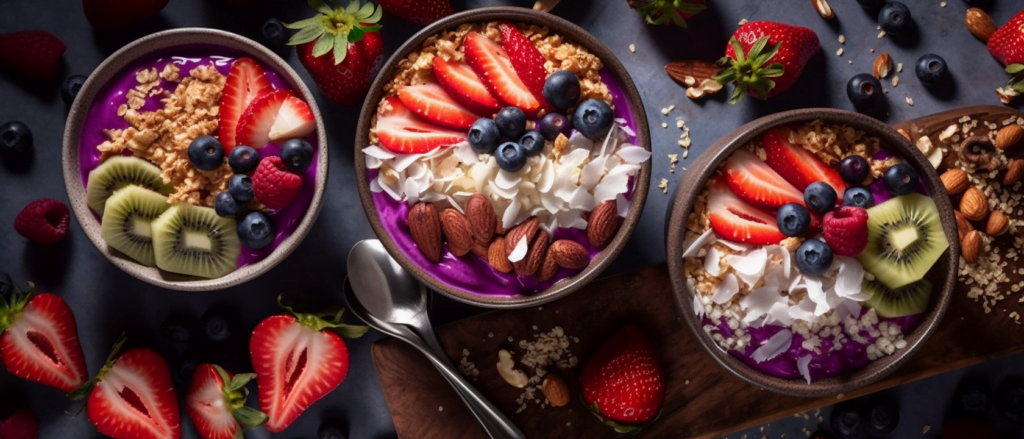
Basic Acai Bowl Recipe
Ingredients:
- 2 frozen unsweetened acai berry packs
- 1/2 cup frozen mixed berries
- 1/2 cup frozen banana slices
- 1/2 cup unsweetened almond milk or other milk of choice
- Optional: 1 tbsp honey or maple syrup for added sweetness
Toppings:
- Sliced fresh fruit (e.g., banana, strawberries, blueberries)
- Granola
- Unsweetened shredded coconut
- Honey or maple syrup (optional)
Instructions:
- Run the acai berry packs under warm water for a few seconds to soften them slightly. Then, break them into chunks and add them to a blender.
- Add the frozen mixed berries, banana slices, and almond milk to the blender. Blend until smooth and creamy, adding more milk to achieve the desired consistency.
- Pour the acai mixture into a bowl and top with fresh fruit, granola, and shredded coconut. Drizzle with honey or maple syrup, if desired. Enjoy immediately.
Green Acai Bowl Recipe
Ingredients:
- 2 frozen unsweetened acai berry packs
- 1/2 cup frozen mango chunks
- 1/2 cup frozen banana slices
- 1 cup baby spinach or kale
- 1/2 cup unsweetened almond milk or other milk of choice
- Optional: 1 tbsp honey or maple syrup for added sweetness
Toppings:
- Sliced fresh fruit (e.g., banana, kiwi, mango)
- Chopped nuts (e.g., almonds, walnuts, pecans)
- Chia seeds or flaxseeds
- Honey or maple syrup (optional)
Instructions:
- Run the acai berry packs under warm water for a few seconds to soften them slightly. Then, break them into chunks and add them to a blender.
- Add the frozen mango chunks, banana slices, baby spinach or kale, and almond milk to the blender. Blend until smooth and creamy, adding more milk to achieve the desired consistency.
- Pour the acai mixture into a bowl and top with fresh fruit, chopped nuts, and chia seeds or flaxseeds. Drizzle with honey or maple syrup, if desired. Enjoy immediately.
Tips for customizing Acai Bowls to fit your preferences and dietary needs
- Experiment with different fruits: Mix and match your favorite frozen fruits to create new flavor combinations.
- Adjust the sweetness: Add more or less honey or maple syrup, or use alternative sweeteners like stevia or agave nectar.
- Boost the protein: Before blending, add a scoop of your favorite protein powder, Greek yogurt, or silken tofu to the acai mixture.
- Choose your milk: Use any variety (e.g., cow’s milk, soy milk, oat milk) to suit your taste preferences and dietary needs.
- Mix up your toppings: Try using different nuts, seeds, or superfoods like goji berries or cacao nibs as toppings to add variety and nutrients.
- Make it low-carb: Use fewer fruits and more leafy greens, and choose low-carb toppings like nuts and seeds.
- Cater to dietary restrictions: Use gluten-free granola for a gluten-free option or dairy-free yogurt for a vegan alternative.
Following these simple recipes and customization tips, you can create delicious and nutritious acai bowls that cater to your preferences and dietary needs.
Where to Find Acai Bowls
Acai bowls can be found at various chains, cafes, and restaurants. Here are some tips on choosing a quality acai bowl and making the best choices when ordering at these establishments.
Popular Acai Bowl chains and cafes
- Jamba Juice: This well-known smoothie chain offers acai bowls made with Acai, bananas, strawberries, blueberries, and granola.
- Nekter Juice Bar: Offering a wide range of acai bowls, Nekter Juice Bar provides options with various fruits, toppings, and add-ons.
- Juice Generation: This popular chain offers several acai bowl varieties, including those with added protein, green ingredients, or a focus on superfoods.
- Tropical Smoothie Cafe: With a range of smoothies and bowls, Tropical Smoothie Cafe offers acai bowls with various fruit combinations and toppings.
- Playa Bowls: This rapidly growing chain specializes in acai bowls and offers numerous options with different fruit bases, superfoods, and toppings.
Remember that local cafes and health food restaurants may also offer acai bowls, so don’t hesitate to explore your local area to discover unique and delicious options.
How to choose a quality Acai Bowl
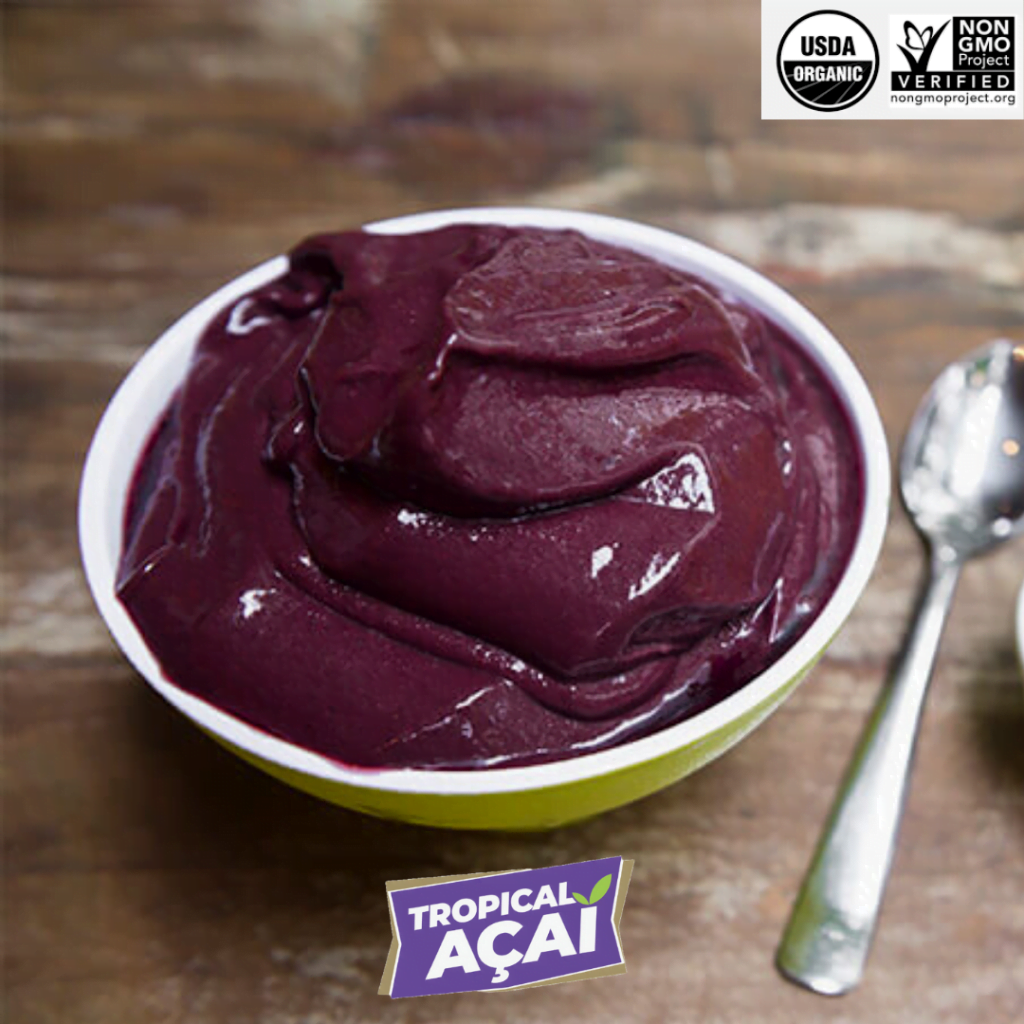
When selecting an acai bowl, consider the following factors:
- Ingredients: Look for bowls made with pure, unsweetened Acai without added sugars, artificial flavors, or preservatives.
- Nutrient density: Choose acai bowls that include a variety of nutrient-dense fruits, toppings, and add-ons, such as berries, nuts, seeds, and leafy greens.
- Portion size: Opt for reasonably sized acai bowls to avoid overeating or consuming excess calories and sugar.
- Customization options: Seek out establishments that allow you to customize your acai bowl with your preferred ingredients and dietary needs.
Tips for ordering Acai Bowls at restaurants and cafes
- Ask about the acai base: Ensure the establishment uses pure, unsweetened Acai without added sugars or artificial ingredients.
- Be mindful of portion size: Choose smaller bowls when available or share a larger bowl with a friend.
- Opt for nutrient-dense toppings: Select toppings such as fresh fruits, nuts, seeds, and superfoods to maximize the nutritional value of your bowl.
- Limit added sugars: Avoid bowls with excessive amounts of sweeteners, and choose natural sweeteners like honey or maple syrup when needed.
- Customize your bowl: Request specific ingredients or toppings to suit your taste preferences and dietary needs.
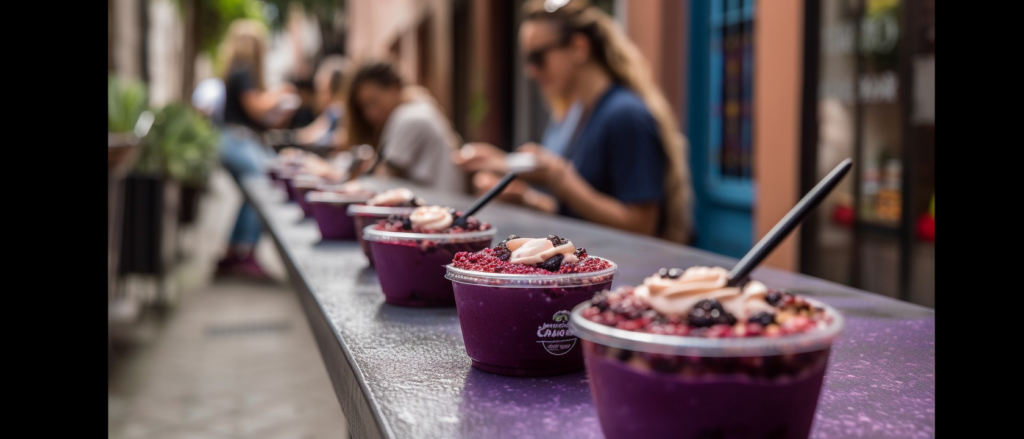
Within these tips, you can find and enjoy delicious, high-quality acai bowls at popular chains, cafes, and restaurants.
Acai Bowl Alternatives
While acai bowls can be a nutritious and delicious choice, there are many other healthy alternatives and superfood dishes you can try to diversify your diet and enjoy a variety of flavors and nutrients.
Healthy alternatives to Acai Bowls
- Smoothie bowls: Like acai bowls, smoothie bowls use different fruit bases, like mango, strawberry, or mixed berries, to create a thick, creamy texture. For a delicious and nutritious meal, top your smoothie bowl with your favorite fruits, nuts, seeds, and granola.
- Greek yogurt bowls: For a protein-packed alternative, try a Greek yogurt bowl. For a tasty and satisfying breakfast or snack, top your yogurt with fresh fruits, nuts, seeds, and a drizzle of honey or maple syrup.
- Chia seed pudding: Combine chia seeds with milk or a dairy-free alternative and let them soak overnight. The result is a thick, pudding-like texture that can be topped with your favorite fruits, nuts, and other toppings for a fiber-rich meal.
- Overnight oats: Mix rolled oats with milk or a dairy-free alternative, yogurt, and your choice of fruits, nuts, and sweeteners, then let the mixture sit overnight in the refrigerator. This creates a creamy, no-cook oatmeal dish that can be enjoyed cold or warmed up in the morning.
- Quinoa bowls: For a savory option, cook the quinoa and use it as a base for your bowl. Add your favorite vegetables, lean proteins, and healthy fats to create a balanced and filling meal.
Similar superfood dishes to try
- Pitaya (dragon fruit) bowls: Like acai bowls, pitaya bowls use the vibrant pink dragon fruit as their base. Blend frozen pitaya with other fruits and top with nutritious ingredients for a colorful and antioxidant-rich meal.
- Green smoothie bowls: Combine leafy greens like spinach or kale with fruits like banana, mango, or pineapple to create a nutrient-dense green smoothie bowl. Top with nuts, seeds, and other superfoods for an extra boost of nutrition.
- Spirulina bowls: These nutrient-dense blue-green algae can be blended with fruits to create a unique and healthful smoothie bowl. Spirulina adds a vibrant blue color and is rich in vitamins, minerals, and plant-based protein.
- Maca bowls: Maca is a root vegetable native to the Andes known for its potential energy-boosting and hormone-balancing properties. Blend maca powder with fruits, milk or a dairy-free alternative, and other superfoods to create a nourishing bowl.
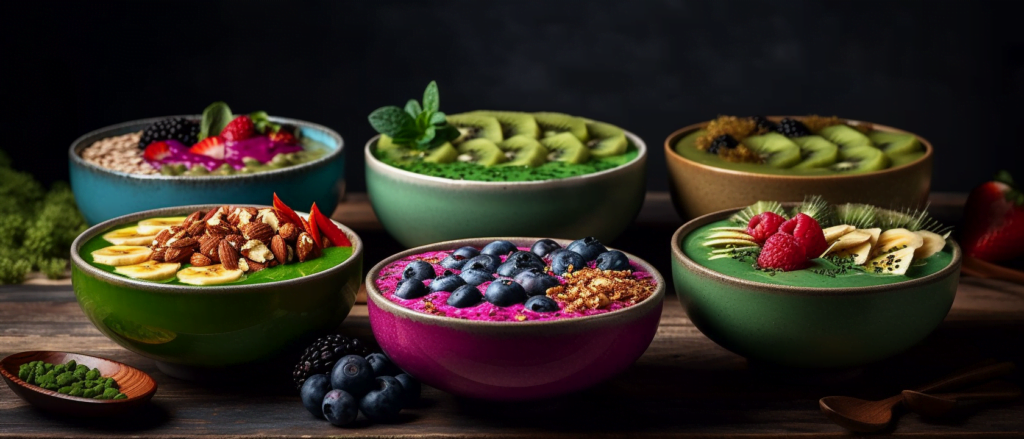
By exploring these healthy alternatives and similar superfood dishes, you can enjoy various nutritious and delicious meals while reaping the benefits of antioxidant-rich ingredients.
Common Misconceptions About Acai Bowls
Acai bowls are a popular superfood dish, but some common misconceptions surround their nutritional value and health benefits. This section will address these myths and help separate fact from fiction.
Addressing common myths about Acai Bowls
Myth 1: Acai bowls are always healthy
While acai berries are rich in antioxidants and other nutrients, not all acai bowls are created equal. Some acai bowls can be loaded with added sugars, large portions, and calorie-dense toppings, negating their potential health benefits. Choosing acai bowls made with pure, unsweetened Acai and nutrient-dense toppings is essential to ensure you consume a healthy option.
Myth 2: Acai bowls are a complete meal
Acai bowls can be a nutritious part of a balanced diet but may not provide all the nutrients needed for a complete meal. Many acai bowls are low in protein and sugar, so balancing your diet with other protein sources and nutrient-dense foods is essential.
Myth 3: Acai bowls are a miracle weight loss food
Acai berries have been touted as a weight loss aid, but limited scientific evidence supports this claim. While acai berries contain fiber and antioxidants, contributing to overall health, consuming acai bowls alone will not lead to significant weight loss. A balanced diet and regular exercise are crucial for achieving and maintaining a healthy weight.
Myth 4: Acai bowls are suitable for everyone
While many people can enjoy acai bowls as part of a balanced diet, they may not suit everyone. Individuals with dietary restrictions
Conclusion
Acai bowls are a popular superfood dish, and for a good reason. Acai berries are packed with antioxidants and other nutrients that can promote overall health and well-being. While acai bowls can be a nutritious and delicious treat, it’s essential to choose wisely and balance them with other nutrient-dense foods.
In this article, we’ve explored acai berries’ origins and nutritional content, the potential health benefits and drawbacks of acai bowls, and how to incorporate them into a balanced diet. We’ve also addressed common misconceptions about acai bowls and separated fact from fiction.
Acai bowls can be healthy when made with pure, unsweetened Acai and nutrient-dense toppings. However, it’s important to be mindful of portion sizes, added sugars, and calorie-dense toppings to ensure you’re consuming a nutritious option. By choosing wisely and balancing your diet with other healthy foods and an active lifestyle, you can enjoy the potential health benefits of acai bowls while maintaining overall health and well-being.
FAQs
Here are answers to some frequently asked questions about acai bowls:
Are Acai Bowls high in sugar?
Acai bowls can be high in sugar if they contain added sugars or sweetened toppings like granola or honey. To reduce sugar intake, choose acai bowls made with pure, unsweetened Acai and choose nutrient-dense toppings like fresh fruit and nuts.
Can Acai Bowls cause weight gain?
Consuming acai bowls alone is unlikely to cause weight gain, but consuming large portions or bowls with calorie-dense toppings may contribute to excess calorie intake. Balancing acai bowls with other nutrient-dense foods and an active lifestyle to maintain a healthy weight.
Are Acai Bowls a good source of protein?
Acai bowls are typically low in protein, but you can add protein-rich toppings like nuts, seeds, and nut butter to increase protein content.
Are Acai Bowls suitable for people with dietary restrictions?
Acai bowls may not be suitable for individuals with dietary restrictions or allergies, as they often contain common allergens like nuts, seeds, and granola. Those with diabetes or blood sugar concerns should also be mindful of the sugar content in acai bowls.
How often can I eat Acai Bowls and still maintain a healthy diet?
Acai bowls can be enjoyed as part of a balanced diet, but moderation is key. To maintain a healthy diet, balance Acai bowls with other nutrient-dense foods and limit consumption of high-calorie toppings.
Are there any risks associated with consuming Acai Bowls?
Consuming acai bowls is generally safe for most individuals, but those with dietary restrictions or allergies should exercise caution. Additionally, consuming large portions or bowls with calorie-dense toppings may contribute to excess calorie intake and potential health risks.
How can I make sure I’m getting a balanced meal when eating Acai Bowls?
Choose acai bowls with pure, unsweetened Acai and nutrient-dense toppings like fresh fruit, nuts, and seeds to ensure a balanced meal. Additionally, consider adding protein-rich toppings to increase protein content.
Do Acai Bowls have any negative impacts on gut health?
There’s no evidence to suggest that acai bowls negatively impact gut health. Acai berries contain fiber, which can support healthy digestion and gut health.
What are the most important things to consider when choosing an Acai Bowl?
When choosing an acai bowl, look for bowls made with pure, unsweetened Acai and nutrient-dense toppings. Additionally, consider portion sizes and sugar content to ensure you consume a healthy option.
Are Acai Bowls worth the price?
The cost of acai bowls can vary depending on the location and ingredients used. While they may be pricier than some other foods, acai bowls can be a nutritious and delicious treat when consumed in moderation and as part of a balanced diet.

